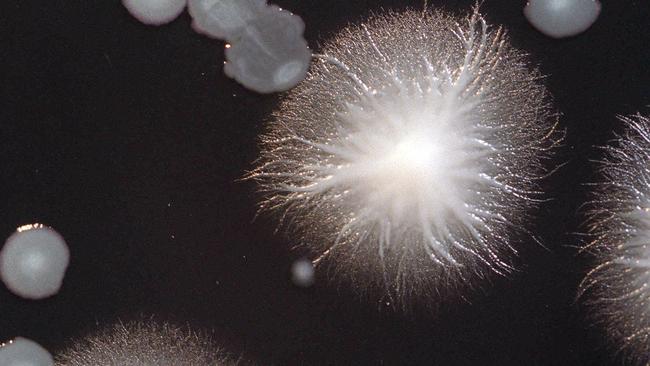What you need to know about Melbourne’s Legionnaires’ disease outbreak
A Legionnaires outbreak in Melbourne has infected more than 20 people. Here’s what you need to know about the outbreak and symptoms of the potentially deadly disease.

Victoria
Don't miss out on the headlines from Victoria. Followed categories will be added to My News.
A Legionnaires’ outbreak in Melbourne involving more than 20 people — the majority of whom have been hospitalised — is under investigation by Victorian health authorities.
Here’s what you need to know about Legionnaires’ disease and the Melbourne outbreak.
What is Legionnaires’ disease?
Legionnaires’ disease is a type of severe pneumonia caused by a bacteria, typically found in wet environments, called legionella bacteria. It is treatable.
What are the symptoms?
The most common symptoms are fever, chills, cough, headache and muscle aches and pains, according to the health department.
Less common symptoms can include confusion, nausea, vomiting and diarrhoea.
What do I do if I have symptoms?
Authorities have urged anyone with symptoms to see a doctor for testing urgently, particularly if they have been in the metropolitan Melbourne area between July 5 and 20.
Royal Melbourne Hospital respiratory medicine Associate Professor Megan Rees said there were “simple” and “rapid” tests, and the treatment was antibiotics.
“The disease is usually very responsive to antibiotics,” she said.

Is Legionnaires’ disease dangerous?
Royal Melbourne Hospital respiratory medicine Associate Professor Megan Rees said Legionnaires’ disease could “present as a very severe illness” in some patients, while others could be asymptomatic.
“Patients are ocassionally very unwell with this pneumonia illness and sometimes require respiratory support, but often it’s a very mild illness as well,” she said.
“Kidney impairment does often occur with very severe legionnaires’ disease.”
Australian National University Infectious Diseases Associate Professor Sanjaya Senanayake said the disease can be fatal, particularly in patients who are considered high risk.
Who is most at risk?
Anyone who is over 40, smokes, has a chronic lung disease, weakened immune system or another underlying medical condition such as diabetes or chronic heart, liver or kidney disease is at higher risk of developing legionnaires’ disease.
Not everyone who is exposed to the bacteria will become sick.
But authorities warned, while most cases in this outbreak were in the higher risk category, there had been cases in “otherwise active and normally healthy adults”.
How does the disease spread?
Professor Rees said the disease cannot be spread from person to person, but via breathing in the bacteria legionella.
“There’s often an incubation period of between two and ten days,” she said.
“We do sometimes see more than one case in a household, that’s usually because they have been exposed to the same source.
Swinburne microbiologist Dr Sarah McLean said the legionella bacteria “thrive in warm water environments”.
This means airconditioning systems, spas, hot water systems, nebulisers, fountains and other similar environments can cause an outbreak if they become contaminated, and quietly infect people who are within a few hundred metres — or in some cases — a few kilometres.
Cooling towers — which are often used to reduce water’s temperature in large, commercial air-conditioning systems — are a common culprit in legionnaires’ outbreaks.
The 2000 Melbourne Aquarium outbreak was traced back to bacteria found in the building’s cooling towers, and authorities suspect a cooling tower in Derrimut or North Laverton is behind the current outbreak.

Why does the bacteria make us sick?
Hudson Institute of Medical Research director Professor Elizabeth Hartland said when we breathe in the bacteria, the immune cells in our lungs “capture” them and “try to them up”.
“But the bacteria can overcome that,” she said.
“So in people with risk factors, their immune system is not good enough to clear it quickly.
“We can’t control the bacteria, and we’re generating a massive inflammatory response, and that’s leading to a really severe form of pneumonia.”
How many people are affected by the current outbreak?
There have been 60 confirmed cases of Legionnaires’ disease — and a further ten suspected — in Melbourne since Friday last week.
Authorities said 59 of the confirmed cases, and seven of the suspected cases, were, or have been, in hospital.
There have been “multiple admissions” to intensive care and a woman, in her 90s, died on Tuesday evening.
Most of the patients are adults aged 40-years-old or above.
Is there a vaccine?
No.
Why haven’t authorities identified the outbreak site yet?
People do not need to go inside the specific building to be exposed to bacteria from a contaminated cooling tower.
Authorities suspect, in some cases, the bacteria could travel up to several kilometres, making it more difficult to narrow down a specific location.
Authorities are testing and disinfecting cooling towers in the general area, but chief health officer Dr Clare Looker said the test results can take up to ten days


